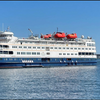Head of Navy Strategic Mobility to Headline IMPACT 2006
CCDoTT will announce the fruits of ten years of advanced research focused on high-speed sealift, a complex multi-technology project combining the Department of Defense needs for delivering both troops and materiel to farflung destinations at ever-faster speeds. CCDoTT¡¦s research ranges widely, from faster ships to new cargo movement techniques to assure cargo leaves the port faster. Specific presentations at the Nov. 16 event will include the following: ƒn
Implementing the world¡¦s first MagLev freight corridor from the ports of L.A./Long Beach; ƒn
ƒnPracticalities of Short Sea Shipping on the Pacific Coast; ƒn
The latest in high-speed ships: ƒn
Computational Fluid Dynamic techniques produce more efficient hulls; ƒn
Military and commercial application of trimarans in high-speed sealift; ƒn
High power density waterjet thrusters enhance slender multi-hull feasibility; ƒn
Essential structural loads for high speed multi-hull vessels ƒn
Agile Port Systems in support of on-dock rail initiatives; ƒn
Review of nuclear power as an increasingly viable alternative for high-speed sealift; ƒn
Review of nuclear power as an increasingly viable alternative for high-speed sealift; ƒn
Agile Port Systems in support of Strategic Port Power Projection Platforms. ƒn
Keynoter Kaskin is Director of the Strategic Mobility/Combat Logistics Division (N42) for the Office of the Chief of Naval Operations, where he oversees the development of Seabase technologies¡Xthe ability to transport, assemble, equip, project, support, and sustain military forces without reliance on land bases in a Joint Operations Area (in a deployment of Army, Marine, and Navy forces). A Seabase capability is particularly helpful in the case of ¡§austere ports,¡¨ such as in less-developed countries or where ports have been destroyed. The Navy is expected to purchase and employ high-speed sealift technologies in less than ten years. ƒn
Kaskin joined the Office of the Chief of Naval Operations (N-42) in October 2000. He is a member of the Senior Executive Service. Following a career in the Navy, in which he spent considerable time in Korea and Japan, he retired with the rank of Captain in 2001. He has two Master¡¦s Degrees, one in Engineering from Harvard, and one in Shipping and Shipbuilding Management from the Massachusetts Institute of Technology. In addition, Kaskin has earned the professional designation of Ocean Engineer.















